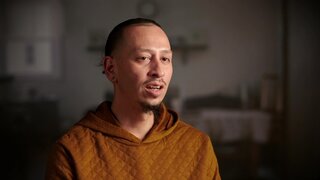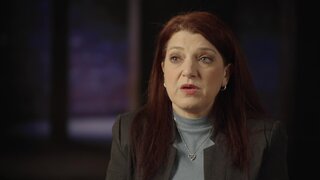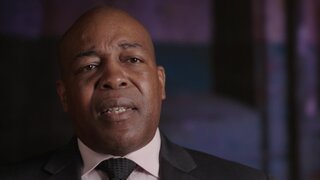Create a free profile to get unlimited access to exclusive videos, breaking news, sweepstakes, and more!
Fatal 2006 Mass Shooting Leads NYC Detectives to Serial Killer Targeting Nightclub Bouncers
When someone shot four people at a N.Y.C. nightclub, leaving one dead, officers from other precincts recognized similarities to the separate murders of three Brooklyn men.
Detectives with the N.Y.P.D. responded to a mass shooting in 2006, unaware that the ensuing investigation would lead them straight to an elusive serial killer.
It started in the late hours of May 23, 2006, when hip hop artists Gustavo “Gus” Cuadros, 24, and longtime friend Yeison “CaLaV3Ra” Correa performed at Opus 22, a nightclub in Manhattan’s Chelsea neighborhood. Both had just finished a set, excited at the prospect of earning their big break following rising success on Myspace.
Gustavo’s brother, Julian Cuadros, attended the concert to show his support.
“It was a really good energy,” Julian told New York Homicide, airing Saturdays at 9/8c on Oxygen. “Everybody was happy; good things were happening.”
RELATED: Dirty Dancing Actress Shot Execution Style in 2001 Carnegie Deli Murders
According to Julian, attendees were exiting the club after the successful gig ended when the first gunshot rang out. He described pandemonium as guests started screaming and rushing to escape. Julian approached a bouncer on the street to inquire what was happening when a second shot rang out, hitting Julian.
“I tried to move and couldn’t move,” he said. “I tried to say something, but nothing came out.”
Gustavo ran to assist his injured brother when a third shot struck and killed him on the spot, causing him to land on Julian’s chest.
“He died on top of me,” an emotional Julian continued.
Outside, Correa recognized the shooter as one of Opus 22’s security guards and struck the assailant in the head with a cash box. The shooter — soon identified as Stephen Sakai — attempted to shoot Correa before his gun jammed, allowing Correa to run away.
Moments later, however, Sakai shot Correa in the back. Thankfully, Correa survived his injuries.
For Correa and those who knew Gustavo best, the murder was senseless. Gustavo, described by Julian as a “happy” and “energetic” man with a love for music, was known for being ambitious. He was a recent college graduate with a business degree and was recently promoted to manager for U.P.S.
“One second we’re living our American dream,” said Correa. “And the next second, it’s being taken away.”
On top of Gustavo’s murder, Julian, Correa, and a third person was critically injured but survived the attack.
A Suspect Is Taken into Custody
N.Y.P.D. officials, including Detective Chris Breslin for the 10th Precinct, arrived quickly at the scene. The shooter, whom several eyewitnesses identified as Sakai, was on the loose and considered armed and dangerous.
It wasn’t long before N.Y.P.D. officers found Sakai heading toward his Brooklyn apartment and brought him to the 13th Precinct for questioning. According to Det. Breslin, Sakai — who was Black — struck investigators as peculiar since he allegedly faked an Asian accent and sported a Fu Manchu mustache.
“From what I knew about him, he was from Brooklyn, born and raised,” Breslin told New York Homicide. “Every once in a while, he would break character.”
Sakai initially denied knowing anything about the Opus 22 mass shooting. Instead, he talked about Cambodian cage fighting and Chinese throwing stars before commenting on an unsolved homicide in Brooklyn.
“And then he started telling us about different homicides in Brooklyn,” said Breslin.
Authorities outside the interrogation room began calling other precincts before several showed interest in the Opus 22 shooting suspect.
The 2005 Murder of Irving Matos
On November 16, 2005, seven months before the Opus 22 shooting, a club manager checked up on his employee, 42-year-old bouncer Irving Matos, at his Sunset Park, Brooklyn, apartment after having no contact. Inside, Matos was dead, as described by Det. Anthony Spencer of the 72nd Precinct.
“Mr. Matos was found sitting on the couch in a comfortable position,” Spencer told New York Homicide.
A postmortem examination revealed the victim was shot in the back of the head, the bullet still lodged in his tongue. A shell casing was also collected from the crime scene.
No signs of a struggle or break-in led detectives to theorize that Matos knew his killer. They turned their attention to Matos’ place of employment, The Sweet Cherry, a Brooklyn exotic dance club known for sex parties, prostitution, and drugs.
RELATED: Detectives Search For Who Stabbed Beloved Spanish Harlem Role Model More Than 50 Times
Aside from working at The Sweet Cherry, Matos also got work from a man named Daniel Fishback, who told detectives that he and Matos had arranged a meeting about one week before Matos’ murder. Fishback and Matos were to discuss a new job with the prospective location’s security guard, Stephen Sakai.
Fishback claimed Matos never arrived.
When ballistics results came back in December 2005, detectives learned the shell casing from the Matos crime scene matched another unsolved murder, that of Edwin “Eric” Mojica.
Ballistics Link Matos to the Murder of Edwin “Eric” Mojica
On Nov. 28, 2005, just 12 days after Matos’ murder and six months before the Opus 22 shooting, police were called to a four-story apartment building in Williamsburg, Brooklyn, according to Det. Jimmy Bodnar of the 90th Precinct. It was around 4:00 a.m. when Mojica — returning from work — was shot just outside his apartment door.
Like Matos, Mojica sustained a single gunshot wound to the back of the head.
“It was straight-up execution,” Bodnar told New York Homicide.
According to Mojica’s girlfriend, Diana — who heard the shooting from beyond the apartment door — Mojica had owned a security group called the Untouchables, comprising of about 25 bouncers who worked at various nightclub locations.
“Eric was the light that walked in the room,” Diana remembered. “People gravitated towards him. He had an amazing spirit.”
Diana reported that a few weeks before Mojica’s murder, Mojica secured an account with Opus 22. He mentioned having an argument with Sakai, who, for detectives, seemed to be the common denominator in the cases of Matos, Mojica, and the Opus 22 shooting.
On the sidewalk outside Mojica’s building, detectives found an unspent casing and wet spit, collecting the sample in hopes that it belonged to the killer.
D.N.A. Matches to the Wayne Tyson Crime Scene
Detectives questioning the Opus 22 shooting suspect successfully collected his D.N.A. after offering Sakai a glass of water. While the physical evidence would later prove to be a match to the spit found at the Mojica crime scene, it was also a match to yet another unsolved Brooklyn homicide.
According to Det. Bob Schulman of the 73rd Precinct, Stephen Sakai was a name new to those investigating the murder of 56-year-old Wayne Tyson. On September 1, 2005, three months before Irving Matos’ murder, Tyson — a bouncer from The Sweet Cherry — was found dead in his Brownsville, Brooklyn, apartment after officers were called to perform a welfare check.
“The landlord had served an eviction notice on one of his tenants there, and I guess he was getting no response,” Schulman told New York Homicide.
Police found Tyson face-up beside his bed, having sustained multiple stab wounds to the torso and slash wounds to the throat. Blood discovered on the bathroom mirror, sink, and toilet indicated a violent struggle.
When questioned about the case, Sakai appeared nervous and sweaty. He admitted to being close friends with Tyson and said he went to support him in response to the eviction notice. But, according to Sakai, Tyson grew agitated and allegedly physically attacked Sakai with a knife, prompting Sakai to wrestle for Tyson’s weapon and kill him first.
“It appeared he was trying to make a self-defense case,” according to Det. Stephen Hunter of the 73rd Precinct. “But the amount of stab wounds to Mr. Tyson, I didn’t believe his story at all.”
Sakai Confesses to Several Murders, But Not All
Stephen Sakai soon copped to the Opus 22 shooting, claiming he was escorting a few people outside following an altercation when an unknown person threw something at Sakai and struck him. Det. Breslin said it “set him off,” prompting Sakai to pull a firearm and shoot at innocent people.
“And then he said he just left,” Breslin told New York Homicide. “We asked him where the gun was, and he actually said he left it on the train.”
As far as the Brooklyn cases, though he claimed self-defense in the Tyson homicide, he admitted to murdering Mojica solely in hopes of taking over Mojica’s security business.
“It could be lucrative, this type of work,” said Det. Bodnar. “It was out of greed.”

However, Sakai was less forthcoming when it came to the murder of Irving Matos. He gave inconsistent details — such as shooting Matos in the stomach — which “puzzled” investigators, such as Det. Spencer. Sakai also claimed it was Daniel Fishback who killed Matos.
In a later interview, Spencer confronted Sakai about his inaccuracies.
Sakai eventually explained that he and Fishback brought Matos to Opus 22 for work but that the club manager turned them away when seeing Matos inebriated for the job interview. The trio returned to Matos’ residence before Sakai shot him in the head.
Fishback later stated he was scared to speak against Sakai, so he kept his eyewitness testimony to himself. Prosecutors declined to charge Fishback in connection to the case.
In the meantime, police searched Sakai’s home for evidence, which Det. Bodnar compared to Silence of the Lambs. Inside were buckets filled with urine and dog feces throughout the apartment, and even a note signed by Sakai that read: “For me to succeed, I have to be a monster in the most positive way.”
The Trials and Convictions
Stephen Sakai faced trial in December 2007 for the Brooklyn murders of Wayne Tyson, Irving Matos, and Edwin “Eric” Mojica. He was ultimately found guilty of the murders of Tyson and Mojica but not of the murder of Matos because, according to Det. Spencer, jurors were skeptical of Fishback’s testimony.
“I was a little taken aback that he wasn’t found guilty in my case, but I was just satisfied that he was no longer on the street,” admitted Spencer. “If he hadn’t been stopped, who knows how many other bodies might have been attributed to him.”
He was sentenced to 50 years to life.
One year later, Sakai faced trial for the second-degree murder of Gustavo Cuadros and the attempted murders of three others, including Julian Cuadros and Yeison Correa. He was found guilty and sentenced to an additional 90 years behind bars.
Despite losing his brother and having to use a wheelchair, Julian called it a “positive” that he survived the attack.
“I was able to raise my kids,” said Julian. “Every day’s a challenge, but we all got challenges. This is mine.”
Watch all-new episodes of New York Homicide, airing Saturdays at 9/8c on Oxygen.




































